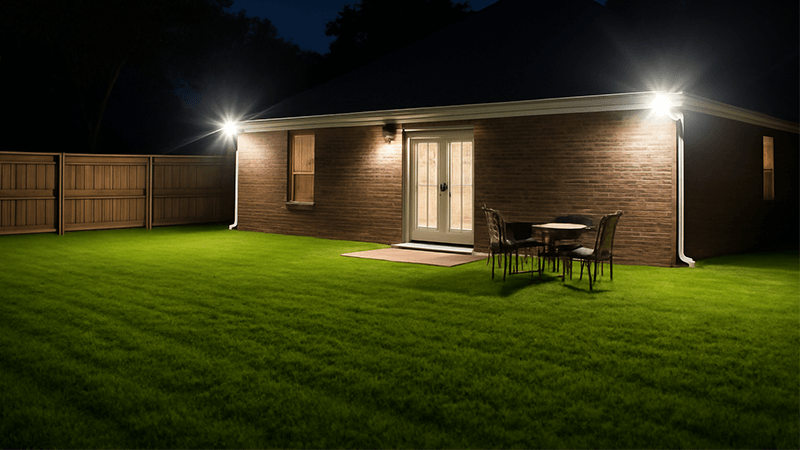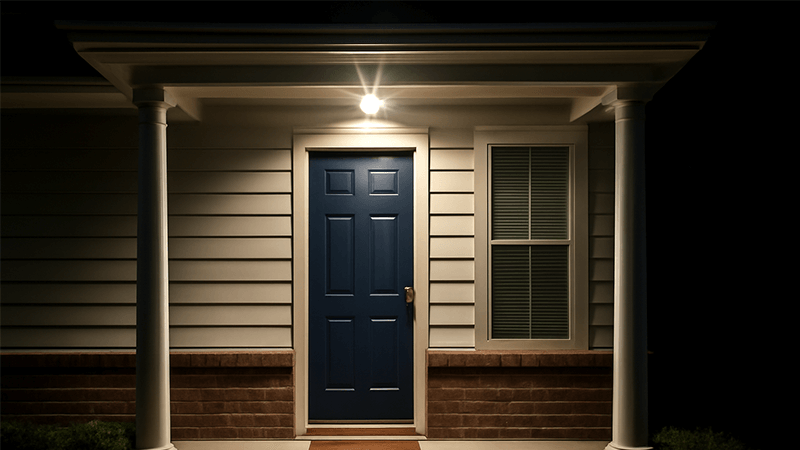Are you struggling to find the right flood light? You need security and visibility, but choosing the wrong brightness can mean wasted energy or a space that’s still too dark.
For most residential outdoor flood lights, 700 to 1500 lumens is ideal. This range provides strong, effective security lighting for driveways, backyards, and pathways without being overpoweringly bright for you or your neighbors. For larger commercial areas, you might need 2000 lumens or more.

Finding the perfect balance of brightness for your outdoor space can feel tricky. You want enough light to feel safe and see clearly, but you don’t want to create an airport runway in your backyard. Over my years in the lighting industry, I’ve helped countless clients like Shaz navigate this exact problem. It’s not just about picking the brightest light; it’s about choosing the right light for the job. Let’s break down what these lumen numbers actually mean so you can make a confident choice.
How many lumens do I need for an outdoor flood light?
Are you worried about choosing a flood light that’s too dim for security or too bright for your neighbors? Picking the wrong lumens can leave your property vulnerable or cause unwanted glare.
A good starting point is 700-1500 lumens for general home security. This provides enough light to illuminate key areas like doors and driveways. For larger yards or commercial spaces, you may need 2000 to 5000 lumens or more, depending on the area size.

Choosing the right lumen output is crucial for effective outdoor lighting. It’s about matching the brightness to the specific task and area. I’ve seen many projects where clients either under-lit a critical security zone or over-lit a small patio, wasting energy and creating an uncomfortable environment. To avoid these common mistakes, let’s look at the specific needs of different outdoor areas. A small entryway doesn’t need the same power as a large commercial parking lot. Understanding this helps you select a product that performs exactly as you need it to, ensuring both safety and efficiency.
Here’s a simple breakdown to guide your decision:
Breaking Down Lumen Needs by Area
To make it easier, I’ve created a table that outlines common outdoor spaces and the typical lumen range you should aim for. Think of this as a starting point. Your personal preference and the specific layout of your property will also play a role.
| Application Area |
Recommended Lumens |
Why this brightness? |
| Pathways & Walkways |
100 – 500 lumens |
Provides safe navigation without creating harsh glare. Focus is on visibility underfoot. |
| Porches & Entrances |
400 – 800 lumens |
Illuminates the doorway for security and welcoming guests. Bright enough to find keys. |
| Driveways & Garages |
700 – 1500 lumens |
Offers good visibility for parking and walking, enhancing security around your vehicles. |
| Backyards & Patios |
700 – 1300 lumens |
Creates a usable, secure space for recreation or relaxation without being overwhelming. |
| Large Yards / Wall Washing |
1500 – 3000 lumens |
Covers a wider area, highlighting architectural features or illuminating the perimeter. |
| Commercial Areas |
3000 – 10,000+ lumens |
Required for large spaces like parking lots or building facades to ensure safety and security. |
Remember, factors like the mounting height and beam angle of the flood light will also affect how the light is distributed. A higher mounting position might require more lumens to deliver the same brightness on the ground compared to a lower one.
How bright is a 2000 lumens flood light?
Wondering if 2000 lumens is overkill for your backyard? You want strong light for security, but you’re afraid of creating a spotlight that bothers everyone in the neighborhood.
A 2000 lumens flood light is very bright, roughly equivalent to a 120-150 watt incandescent bulb. It’s excellent for illuminating large areas like a two-car driveway, a spacious backyard, or the side of a building from a distance of about 20-30 feet.

A 2000-lumen flood light is a significant step up in brightness and is often considered the entry point for more serious security or area lighting. I remember working with a client who wanted to light up his entire backyard for his kids to play in during the evenings. We installed a couple of 2000-lumen fixtures, and it completely transformed the space from a dark, unused area into a safe and active playground. However, this level of brightness requires careful placement. You need to angle it correctly to avoid shining light into your neighbor’s windows or creating unsafe glare for passing cars. It’s powerful, so you have to use that power wisely.
Understanding the Impact of 2000 Lumens
So, what can you realistically expect from a 2000-lumen flood light? It’s not just about a number; it’s about practical application. This level of brightness is where you move from simple path lighting to true area illumination.
Here’s what 2000 lumens is best for:
- Large Residential Backyards: It can effectively light up a space of around 400-600 square feet, making it perfect for security and nighttime activities.
- Driveway Security: Mounted above a garage, it will clearly illuminate a two-car driveway and the surrounding area, deterring potential intruders.
- Wall Washing: If you want to highlight the architecture of your home, a 2000-lumen light can wash a two-story wall with a strong, even light.
- Small Commercial Spaces: Think small parking areas, loading docks, or storefronts. This brightness provides clear visibility for safety and operations.
When considering a 2000-lumen fixture, also look at the beam angle. A wider beam angle (like 120°) will spread the light over a larger area, but it will be less intense. A narrower beam angle (like 60°) will concentrate the light, making it appear brighter in a smaller spot. For large backyards, a wider beam is usually better. For highlighting a specific feature, a narrower beam is more effective.
How bright is a 700 lumens floodlight?
Do you just need to light a small area, like your front door? You might be thinking that a high-lumen floodlight is too much, leading to wasted energy and excessive brightness.
A 700 lumens floodlight provides solid, focused brightness, similar to a 60-watt traditional bulb. It is perfect for lighting up smaller, specific areas like doorways, porches, garden features, or short pathways without creating overwhelming glare. It offers a great balance of visibility and subtlety.

A 700-lumen floodlight is my go-to recommendation for targeted residential lighting. It’s the workhorse for everyday security and convenience. I’ve installed hundreds of these for clients who just need to light up their entryway to find their keys or illuminate a dark corner of their patio. It provides a clear, bright light that makes you feel secure without turning your home into a stadium. It’s efficient, effective, and neighbor-friendly—a perfect combination for most homes. You get the safety you need without the unnecessary light pollution.
Where 700 Lumens Shines Brightest
Don’t underestimate the power of 700 lumens. While it might not sound as impressive as 2000 or 5000, it’s often the perfect solution. Using too many lumens is just as bad as using too few. It wastes electricity and can ruin the ambiance of your outdoor space.
Here are the ideal applications for a 700-lumen floodlight:
- Front Door and Porch Lighting: This is the most common use. It provides ample light to see visitors, unlock your door, and deter anyone lurking in the shadows.
- Pathway Illumination: For a short walkway from your driveway to your door, a 700-lumen fixture is more than enough to ensure safe passage.
- Highlighting Garden Features: If you have a statue, a small tree, or a beautiful plant you want to showcase at night, 700 lumens will do the job beautifully without washing out the colors.
- Step and Stair Lighting: Placing a fixture to illuminate a small set of outdoor stairs is a critical safety measure, and 700 lumens is the perfect brightness for this.
For these applications, a 700-lumen light is not just adequate; it’s optimal. It provides the necessary illumination with minimal energy consumption, making it a smart and cost-effective choice for enhancing the security and beauty of your home.
What is the difference between 4000 and 5000 lumens?
Are you deciding between two high-power flood lights and can’t tell the difference? A 1000-lumen gap sounds big, but you’re unsure if it’s a noticeable change or just a marketing number.
A 5000-lumen flood light is 25% brighter than a 4000-lumen one. While both are very bright, the 5000-lumen option is better for illuminating larger areas or when mounting the light higher up. The difference is noticeable, especially in commercial or large-scale residential applications.

When we get into the 4000-5000 lumen range, we are talking about serious lighting for commercial properties, large parking lots, or very large residential estates. The 1000-lumen difference is tangible. Think of it this way: a 4000-lumen light might be perfect for a small business parking lot with 4-5 spaces. But a 5000-lumen light could cover 6-7 spaces with the same level of effective brightness. As a manufacturer, I know that reaching these higher lumen counts efficiently and reliably is a challenge. It’s not just about adding more power.
Choosing Between High-Lumen Options
The decision between 4000 and 5000 lumens depends entirely on the scale of your project. Let’s dig deeper into when that extra 1000 lumens makes a real difference.
| Factor |
4000 Lumens |
5000 Lumens |
The Verdict |
| Coverage Area |
Good for areas up to ~1000 sq ft. |
Better for areas up to ~1250 sq ft. |
For larger spaces, 5000lm provides more uniform coverage. |
| Mounting Height |
Ideal for heights of 15-20 feet. |
Better suited for heights of 20-25 feet. |
The extra lumens compensate for light loss over a greater distance. |
| Application |
Small commercial lots, large driveways. |
Medium commercial lots, building facades. |
5000lm is a step into more professional, high-demand lighting. |
| Perceived Brightness |
Very bright. |
Noticeably brighter, almost crisp. |
The difference is clear to the naked eye in a side-by-side comparison. |
An Insider’s Warning: In the quest for higher lumen values, some manufacturers take shortcuts. I’ve seen factories add fluorides to the fluorescent powder inside the LED chips. This does boost the initial lumen output, making the specs look great on paper. However, fluorides are highly susceptible to moisture. Even a tiny amount of humidity can seep into the LED package over time, causing the LED chip to fail prematurely. This is why at iPHD, we focus on quality components and robust engineering over inflated marketing numbers. A reliable 4000-lumen light is always better than an unreliable 5000-lumen one. When you’re sourcing high-power lights, always ask the supplier about their chip technology and moisture protection methods.
Conclusion
Choosing the right lumens, from 700 for a porch to 5000 for a commercial lot, ensures your space is safe, functional, and efficient. It’s about matching brightness to the task.